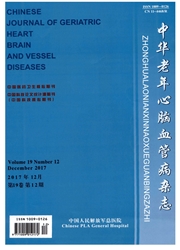

 中文摘要:
中文摘要:
目的探讨老年脑血管病急性发病MRI一站式诊断可行性以及MRI弥散加权成像(DWI)和T_2*WI联合应用对老年脑血管病急性发病的价值。方法选取老年脑血管病急性发病患者337例的CT和MRI影像,对比CT和MRI对脑梗死、脑出血、动脉瘤和脑小血管病(脑微出血、腔隙性脑梗死灶和脱髓鞘变性)显示;对比MRI各扫描序列对病灶的显示,包括常规序列、DWI和T_2*WI。结果 337例脑血管病急性发病患者行CT检查208例,MRI检查314例;急性脑梗死患者236例,CT示颅内出血76例;CT与MRI对于急性脑梗死的显示,差异有统计学意义(17.8%vs 75.2%,P〈0.01),CT不能显示脑干的急性梗死灶;CT对于脑小血管病的显示明显低于MRI,差异有统计学意义(P〈0.05),CT不能显示脑微出血。MRI常规序列与DWI对于急性脑梗死的显示比较,差异有统计学意义(5.2%vs 100.0%,P〈0.01);脑出血灶各序列显示,差异无统计学意义(P〉0.05);MRI各序列对脑微出血T_2*WI显示病灶715个(100.0%),DWI显示635个(88.8%),常规序列图像少部分微出血灶信号异常,但是不能定性诊断。结论 MRI在老年脑血管病急性发病危重症患者除外诊断中一站式诊断可行,联合应用DWI和T_2*WI对老年脑血管病急性发病显示良好。
 英文摘要:
英文摘要:
Objective To study the role of combined DWI and T_2*WI in diagnosis of acute cerebrovascular diseases.Methods Ischemic stroke,cerebral hemorrhage,aneurysm and microvascular disease in 337 elderly patients with acute cerebrovascular disease were detected by CT and MRI respectively.Acute cerebrovascular diseases detected by DWI and T_2*WI were compared.Results The incidence of acute cerebrovascular disease detected by CT was significantly lower than that detected by MRI(17.8% vs 75.2%,P0.01).The incidence of cerebral microvascular hemorrhage detected by CT was significantly lower than that detected by MRI(P0.05).The incidence of acute cerebrovascular disease detected by conventional MRI was significantly lower than that detected by DWI(5.2%vs 100.0%,P0.01).No significant difference was found in cerebral hemorrhage detected by DWI and T_2*WI(P0.05).The rate of lesions(715)detected by T_2*WI was significantly higher than that of lesions(635)detected by DWI(100.0%vs 88.8%).Conclusion Combined DWI and T_2*WI can effectively detect acute cerebrovascular diseases in the elderly.
 同期刊论文项目
同期刊论文项目
 同项目期刊论文
同项目期刊论文
 Mutual information based three-dimensional registration of rat brain magnetic resonance imaging time
Mutual information based three-dimensional registration of rat brain magnetic resonance imaging time Real-time magnetic resonance imaging visualization and quantitative assessment of diffusion in the c
Real-time magnetic resonance imaging visualization and quantitative assessment of diffusion in the c 期刊信息
期刊信息
